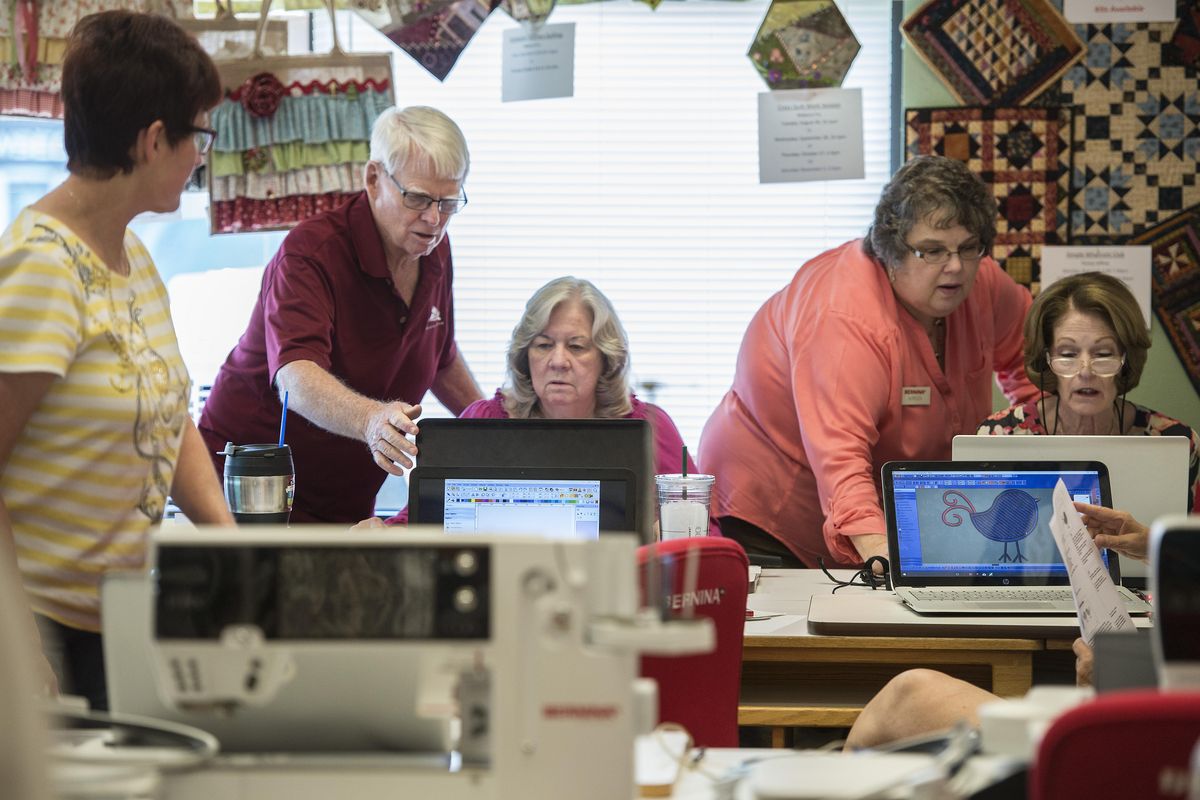High-tech sewing machines help bring men to the hobby

After Al Moeller’s wife bought an embroidery sewing machine a few years ago, he peeked over her shoulder to see how it worked. A 72-year-old woodworker, Moeller was instantly hooked.
“I said, ‘That looks like fun,’ ” said Moeller, who soon started dabbling with his own sewing projects. “Embroidery machines have come a long way because of technology.”
“It’s like you’re an engineer with fabric. You’ve got to line it up and square it up, make sure you have the right amount of fabric. But you pick out your own colors, so you’re the artist.”
He took sewing classes in Spokane Valley, and after nearly taking over the sewing nook at home, he bought his own machine a few months ago.
“I’ve been working on a farm country quilt, and there’s 27,000 to 38,000 stitches per block,” Moeller said. “As long as I’m creating something, I’m having fun.”
Computerized sewing machines sold today do much more than stitch a straight line or create a button hole. High-end models pack technology with digital screens, tool attachments and software-backed design options. The gadgetry is part of the appeal, say some men in the area who have taken up the hobby both for relaxation and craftsmanship.
The machines can range in cost from $2,600 to $14,000 for a commercial-quality embroidery machine.
Wendell Harrell, 58, took up the hobby about a year and a half ago during a brief period of unemployment. He’d done a little sewing in his past for the drapery business. After a two-day Spokane seminar in 2014 to learn more about the craft, he traded in a newly purchased embroidery machine for a high-end Bernina machine.
“I got the Bentley,” he joked. “My newest machine is just over a year old. I have 6 million stitches on it already, so that’s how much embroidery I’ve done.”
He’s made lace Christmas ornaments, iPad bags for friends and neighbors and monogrammed shirts, napkins and place mats.
“Embroidery is becoming more mainstream,” Harrell said. “Everyone loves stuff that’s monogrammed or personalized, so it’s becoming very popular. It used to be something that only you could get commercially, and now it’s coming to the home market. It’s fun. For family and friends, it makes gifts that are personal.”
He spent so much time at the Quilting Bee for classes and to help others for free, the store owners decided to hire him to work part-time in 2014.
Cusick resident Larry Brown began sewing and embroidery projects about 15 years ago as an activity he could do with his wife, Pam. Now 79, he has created designs ranging from fishing-themed quilts to an apron he designed for a neighbor.
Brown still takes advanced machine embroidery classes to learn greater details for computer-aided design and software use.
“One of the neighbors asked me to make a couple of aprons for him, and a couple turned into nearly a dozen; I did the design from scratch,” Brown said. “I find it intellectually challenging. To sew the doggone seams straight so all the points meet where they need to, yeah, that’s a challenge.”
Harrell said embroidery machines can take a hoop attachment, similar to what artisans use when hand-embroidering or hand-quilting.
“The machine moves the hoop, as the machine is stitching; that’s how you get design,” he said. “It’s definitely a craft because you have to have the right tools, batting, fabric, also a stabilizer or backing. There’s software, but most of the machines will allow you to manipulate the design to enlarge it or to move in a multidirectional way.”
Leo Collins, 78, approaches his projects with an artist’s eye. The Spokane resident started sewing about 20 years ago after retiring, and he creates his own designs, often based on another hobby he enjoys, photography. One appliqued wall-hanging depicts a 1937 Chevy truck he saw and photographed in a Green Bluff field.
He makes a design for the fabric wall-hangings from enlarged photocopies of pictures he’s taken. He selects fabric colors and sometimes applies a dry-brush technique to paint on the fabrics.
“I make art quilts,” said Collins, who also has taken several lessons at the north Spokane store, Sew Uniquely You. “I used to help out my mother when I was a kid with her sewing machine, so when I got ready to retire, I bought a machine.”
His wife, Michal Collins, said the hobby also gives him something to do when he isn’t golfing. She doesn’t enjoy sewing, but she appreciates her husband’s projects adorning their walls.
“He uses his regular sewing machine to do some embroidery,” she said. “He’s done old trucks, wagon wheels. He can spend hours.”
Brown also has used the craft to embroider a military cap, and he’s made intricate star-shaped spiral designs without modern software.
“I’m also an ex-teacher of mathematics, and just watching the geometry develop is interesting,” he said. “I don’t know if people realize how much serious geometry is involved.”
A neighbor once teased Brown about his newfound hobby, until seeing a finished product.
“He said he’d really rather see me on the firing range,” Brown said. “Then when I brought him his quilt, he was impressed. Later, when we went to the firing range, he said, ‘Yeah, you better stick with quilting.’”